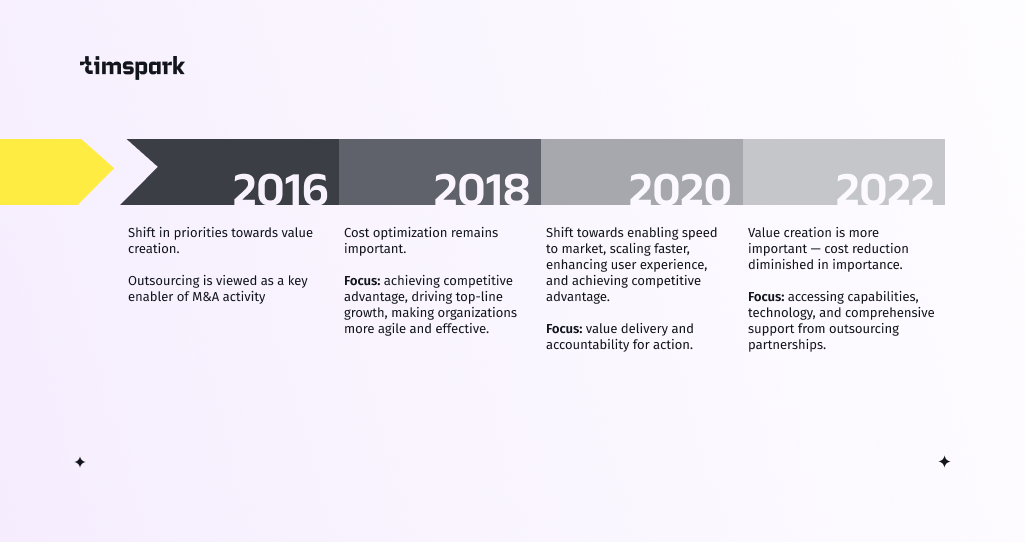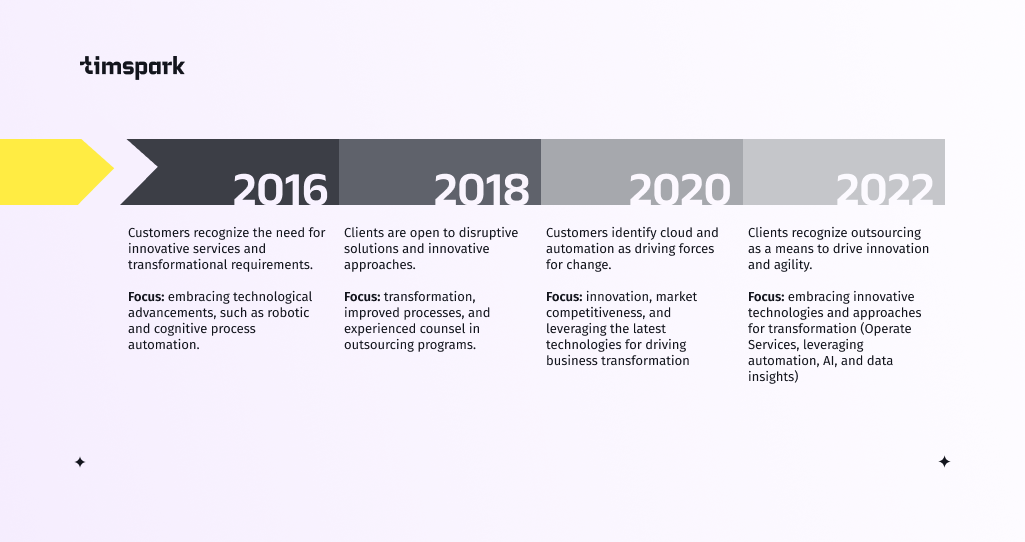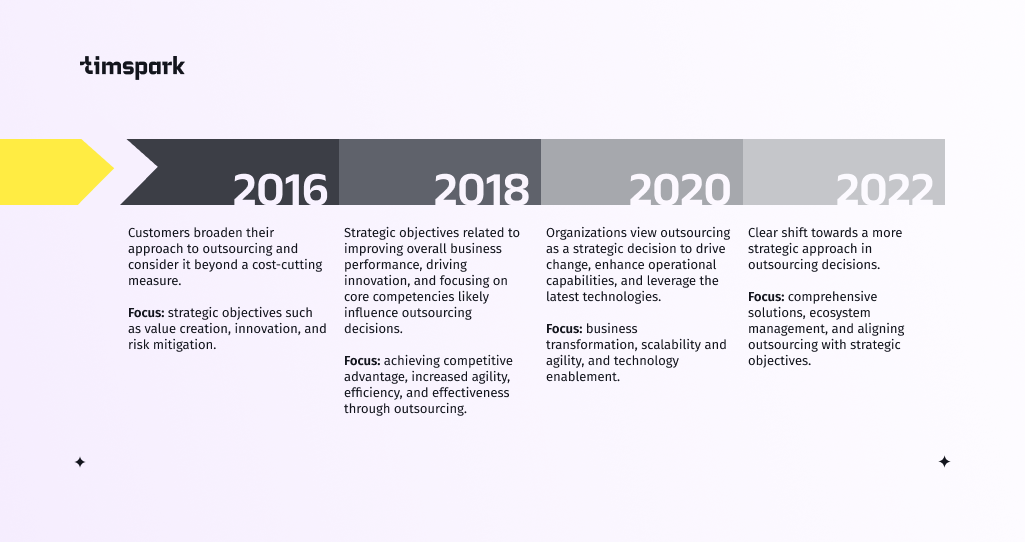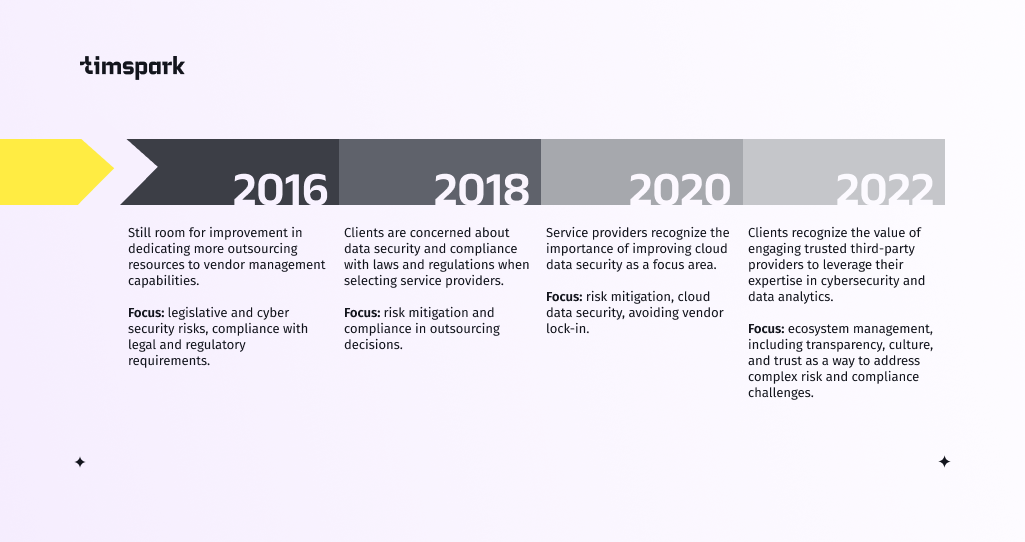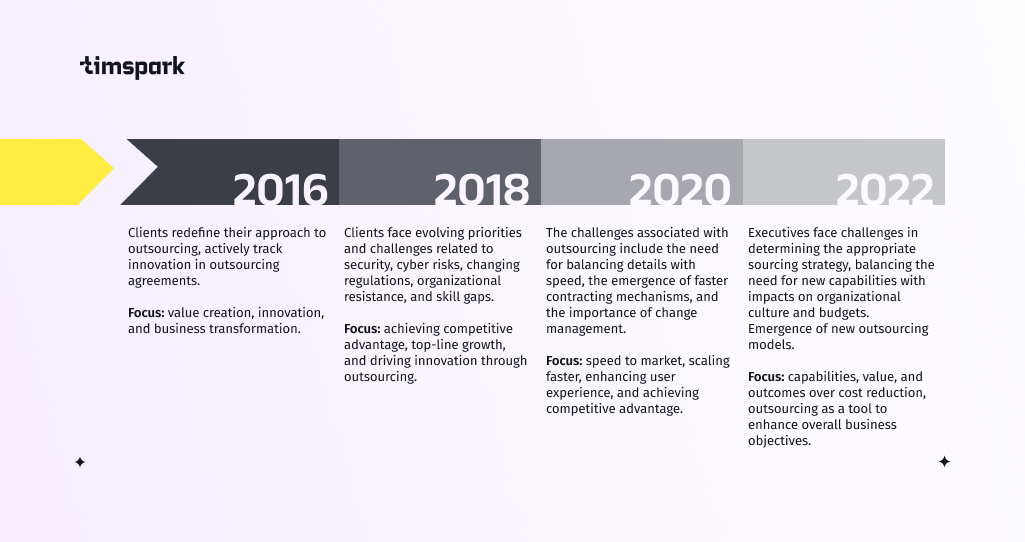The Evolution of Outsourcing: From Cost Reduction to Strategic Value Creation
Vlad Nemshon, Chief Commercial Officer
July 7, 2023
The shifting landscape of the business world brings new challenges to the forefront, causing clients’ expectations from outsourcing to change as well. In such dynamic conditions, outsourcing is gaining more significance, offering tangible benefits beyond mere cost savings, contrary to traditional perceptions. Third-party delivery models, in turn, keep evolving to address modern operating models.
To illuminate customers’ evolving priorities over the past 5–7 years and understand the current direction of outsourcing, we have conducted a comprehensive analysis of four Deloitte reports from 2016 to 2022.
Consequently, Vlad Nemshon, Chief Commercial Officer at Timspark, shares insightful and not-so-obvious findings regarding the evolution of outsourcing and clients’ expectations in this article. Backed up with Timspark’s extensive experience in the field, we delve into an enriched perspective on this topic.
Models of outsourcing services: what’s new
As organizations strive for growth, they encounter the challenges of a fiercely competitive global talent market. These are coupled with rapid technological advancements that surpass practical adoption timelines.
In this demanding situation, where balancing cost and accessing new skills and capabilities is crucial, organizations call upon agile and integrated service providers. While project-based outsourcing is still the most common type of third-party delivery service, businesses are becoming more open to new outsourcing models.
As businesses evolve, the services they seek from providers shift towards more intricate and essential functions. This demand goes beyond traditional capabilities and fosters closer integration with internal and external talent. In fact, 45% of executives embrace new outsourcing models to address changing regulatory requirements. By partnering with third-party providers, organizations gain the needed technology and process guidance and can tap into their deep industry knowledge.
As businesses evolve, their demand goes beyond traditional capabilities and fosters closer integration with both internal and external talent.
Deloitte, in particular, coins such new outsourcing models as Operate Services. These possess several distinguishing features:
- They prioritize outcomes and innovation, leveraging technology and cost optimization;
- They grant clients on-demand access to rare talents, experiences, skills, and cutting-edge technology;
- The scope of services they offer is extensive and adaptable, fostering a highly collaborative relationship with the vendor that often feels like an extension of the organization.
We at Timspark developed a unique approach of core teams, filling the gap left by traditional outsourcing models. Other relatively new outsourcing models are Team as a Service (TaaS) and Dedicated Teams.
While specific terminologies may differ across services, the key aspect is that these disruptive models employ automation and data insights to drive value within their services.
Now, let’s delve deeper into each factor that shapes the outsourcing landscape and new collaboration models and examine its evolution over the past five to seven years.
Shifting priorities from cost reduction to value creation
The last 5-7 years revealed a significant shift in clients’ outsourcing priorities as they recognized broader benefits of outsourcing beyond cost savings.
In 2016, clients recognized that outsourcing could deliver tangible benefits beyond cost savings. They viewed outsourcing as a critical enabler of M&A activity and sought value-added benefits, strategic impact, and innovation from outsourcing partnerships. This indicated a shift in priorities toward value creation.
In 2018, the objectives of outsourcing moved towards enabling speed to market, scaling faster, enhancing user experience, and achieving competitive advantage. There was an emphasis on value delivery and accountability for action, as disappointment in value delivery led to bringing work back in-house.
Comparing a 5-years’ difference (from 2016 to 2020), one may notice a bounce back to cost reduction as a priority for a great number of organizations. The impact of COVID-19 bringing an uncertain economic environment played a key role here.
From 2018 to 2022, the trend toward value creation intensified, and cost reduction diminished in importance. Clients focused on accessing capabilities, technology, and comprehensive support from outsourcing partnerships.
In 2022 value creation became a key focus, reflecting the evolving nature of outsourcing relationships and their strategic value to organizations. In particular, clients started to see outsourcing as vital for M&A activity, seeking value, strategic impact, and innovation.
Timspark’s take on the trend
As clients increasingly focus on accessing new capabilities, leveraging technology, seeking collaboration with service providers, and value creation, we at Timspark keep up the pace.
Rather than focusing solely on cost reduction, we take advantage of outsourcing and Team-as-a-Service (TaaS) models yet enhance them with our bold vision of dedicated teams with unique expertise and high motivation. We believe that comprehensive support and transparency during all the stages of product development, from the discovery phase to launch, help drive value to the business.
Software Development Companies Rates in 2023
Embracing innovation and digital transformation
From 2016, the overall trend suggests an evolving mindset toward embracing innovation and transformation as key considerations in outsourcing strategies.
In 2016, customers recognized the need for innovative services and transformational requirements facilitated by technological advancements. They sought service providers who could offer innovative solutions and enable business growth. The importance of embracing technological advancements, such as robotic and cognitive process automation, was recognized for driving transformational change.
In 2018, clients were open to disruptive solutions and innovative approaches, actively considering how to change solutions, which partners could elevate them, and how to incentivize continual innovation. There was a proactive and forward-thinking attitude toward leveraging new technologies and approaches to drive innovation and transformation.
For the year 2020, the Deloitte report mentioned the importance of innovation, market competitiveness, and leveraging the latest technologies for driving business transformation. Clients sought providers who could help them embrace disruptive technologies and identified cloud and automation as driving forces for change.
From 2018 to 2022, the importance of innovation and transformation in the outsourcing industry is consistently recognized. Clients increasingly seek innovative services, disruptive solutions, and the ability to leverage new technologies to drive business transformation and stay competitive. The shift in priorities from cost reduction to value creation aligns with this focus on embracing innovation and transformation.
Timspark’s take on the trend
Following the evolving trend toward innovation, teams at Timspark tap into cutting-edge technologies and best practices for software development, such as automation, AI, data management, cloud computing, and more, to drive digital transformation for businesses.
Shift to a strategic objectives approach
Tracing the trends, one can notice that customers have evolved their understanding of outsourcing from a cost-centric approach to a strategic approach focused on achieving value, driving transformation, and aligning with long-term business objectives.
2016
The information provided in the report implies that customers were broadening their approach to outsourcing and considering it beyond a cost-cutting measure. Strategic objectives such as value creation, innovation, and risk mitigation were becoming increasingly important. Customers sought innovative solutions, recognized the value of outsourcing for business growth, and saw it as a means to mitigate legislative and cyber security risks.
2018
While the texts did not explicitly discuss strategic objectives, there was an emphasis on achieving competitive advantage, increased agility, efficiency, and effectiveness through outsourcing. This suggests that strategic objectives related to improving overall business performance, driving innovation, and focusing on core competencies likely influenced outsourcing decisions.
2020
While the texts did not explicitly discuss strategic objectives, there was an emphasis on achieving competitive advantage, increased agility, efficiency, and effectiveness through outsourcing. This suggests that strategic objectives related to improving overall business performance, driving innovation, and focusing on core competencies likely influenced outsourcing decisions.
2022
The report explicitly mentioned a shift in the outsourcing mindset from a tactical cost-saving approach to a strategic focus. Clients prioritized capabilities, value, and outcomes over cost reduction, indicating a recognition of the broader benefits outsourcing can offer. Clients sought comprehensive end-to-end solutions and emphasized ecosystem management across vendors for transparent and integrated support aligned with their strategic objectives.
From 2018 to 2022, there is a clear shift towards a more strategic approach in outsourcing decisions. Clients increasingly prioritize strategic objectives such as value creation, business transformation, scalability, agility, and technology enablement. There is a recognition that outsourcing can be a tool to achieve broader business goals and drive change. The focus on comprehensive solutions, ecosystem management, and aligning outsourcing with strategic objectives further emphasizes the strategic nature of outsourcing decisions in 2022.
Timspark’s take on the trend
At Timspark, we see our role in the project as strategic partners, not just executives. Our semi-independent Core Teams accumulate expertise in both — the technological vertical and business domains. They bring their motivation and product vision at all stages of development, striving for the project’s success in the long run.
Risk mitigation and refulations compliance
Overall, the trends indicate that risk mitigation and compliance remain key considerations for clients in outsourcing. One can notice an increasing emphasis on proactive management, addressing changing regulations, data security, and leveraging specialized expertise.
In 2016, customers recognized legislative and cyber security risks as a priority and saw outsourcing as a means to mitigate these risks. Compliance with legal and regulatory requirements was also implied as a concern. However, the report indicated room for improvement in dedicating more outsourcing resources to vendor management capabilities.
In 2018, organizations were increasingly proactive in managing cyber risk and took steps to address security, changing regulations, organizational resistance, and skill gaps. Clients were concerned about data security and compliance with laws and regulations when selecting service providers, and they enforced data risk and security protocols through contractual agreements and periodic evaluations. The emphasis was on risk mitigation and compliance in outsourcing decisions.
According to the report, as of 2020, risk mitigation was a key concern for organizations in outsourcing. Clients sought more robust mechanisms for risk mitigation, aimed to avoid vendor lock-in, and expressed concerns about cloud data security. Service providers recognized the importance of improving cloud data security as a focus area. Risk mitigation and compliance remained significant considerations.
From 2018 to 2022, there is a consistent focus on risk mitigation and compliance in outsourcing decisions. Clients continue to prioritize these aspects and seek outsourcing partners who can provide comprehensive support in managing risks and ensuring compliance. They also recognize the value of engaging trusted third-party providers to leverage their expertise in cybersecurity and data analytics. Ecosystem management, including transparency, culture, and trust, was emphasized to address complex risk and compliance challenges.
Timspark’s take on the trend
We take a proactive approach by bridging the gap between Delivery and potential clients and between Presales and Delivery. We aim to minimize risks from the early stages by involving the Core Team and Team Manager during presales. They study your requirements, suggest ways to bring them to life, and provide estimates. This collaboration ensures the proper transfer of guidelines and vision to the Delivery (Core Team), resulting in a shared understanding and commitment.
High-performance certified teams with domain expertise and an experienced project manager in charge provide for compliance with industry-specific regulations and standards, such as ISO, GDPR, and HIPAA, while regular security controls, encryption mechanisms, and data protection protocols help meet compliance requirements.
Evolving priorities and challenges
Overall, the trends indicate that risk mitigation and compliance remain key considerations for clients in outsourcing. One can notice an increasing emphasis on proactive management, addressing changing regulations, data security, and leveraging specialized expertise.
The information from the report suggests that, as of 2016, companies were broadening their approach to outsourcing and recognizing it as more than just a cost-cutting strategy. There was a shift towards focusing on value creation, innovation, and business transformation. Clients were redefining their approach to outsourcing and actively tracking innovation in outsourcing agreements. The recognition of evolving challenges related to cybersecurity was also evident.
The year 2018 marked a shift in the focus of outsourcing from traditional work transfer to upfront transformation and automation. The emphasis moved towards achieving competitive advantage, top-line growth, and driving innovation through outsourcing. Clients faced evolving priorities and challenges related to security, cyber risks, changing regulations, organizational resistance, and skill gaps. Proactive measures, including contractual enforcement of data risk and security protocols, were taken to address these challenges.
In 2020, the outsourcing landscape was constantly evolving with new disruptive solutions. The outsourcing priorities shifted towards market speed, scaling faster, enhancing user experience, and achieving competitive advantage. The challenges associated with outsourcing included balancing details with speed, the emergence of faster contracting mechanisms, and the importance of change management.
Overall, from 2018 to 2022, there was a noticeable shift in client attitudes towards outsourcing. While cost optimization remained important, there was a clear focus on achieving competitive advantage, driving innovation, and aligning outsourcing with strategic goals. Clients faced evolving priorities and challenges related to security, cultural impact, and budget considerations. The emphasis on collaboration, value creation, and the emergence of new outsourcing models demonstrated the need for innovation and transformation in addressing evolving priorities and challenges.
Timspark’s take on the trend
The shift in the outsourcing mindset from a tactical cost-saving approach to a strategic focus leads the way for vendors. As clients view outsourcing as a tool to enhance overall business objectives, outsourcing partners should also prioritize capabilities, value, and outcomes. This may happen only in tight collaboration with service providers and constant synchronization on the vision of the value creation.
Partnering with Timspark, you will always be in the know about the development process, retain quality control throughout the project, and keep it aligned with your company’s objectives at all stages.
In conclusion
Summing up all the above mentioned processes, clients recognize outsourcing as a strategic enabler for achieving long-term business objectives, driving innovation, and ensuring sustainable growth.
Here are the main takeaways you may consider:
- There is a vivid shift in priorities from cost reduction to value creation, emphasizing strategic objectives, innovation, risk mitigation, and compliance.
- Clients increasingly recognize the broader benefits of outsourcing beyond cost savings and prioritize competitive advantage, agility, and effectiveness.
- There is a growing focus on embracing innovation and transformation, leveraging new technologies, and driving business growth.
- Strategic considerations such as value creation, scalability, and technology enablement are now central to outsourcing decisions.
- Risk mitigation and compliance remain key concerns, with clients seeking trusted providers to address cybersecurity and regulatory requirements.
- The evolving nature of priorities and challenges necessitates a flexible and proactive approach to outsourcing driven by collaboration, value creation, and new outsourcing models.
The attitude towards outsourcing has undergone a significant transformation, with clients embracing a broader perspective encompassing strategic value creation, innovation, risk management, and agility. While cost reduction remains a factor, it is now accompanied by a more holistic approach to achieving long-term business goals. By leveraging the expertise of external service providers, organizations can unlock new opportunities, drive innovation, and achieve sustainable growth.
About the author
Vlad Nemshon, Chief Commercial Officer at Timspark, has 5+ years of experience in IT marketing and sales and a lawyer background at Deloitte. With a talent for extracting valuable insights from data and identifying untapped marketing opportunities, Vlad’s passion lies in translating research findings into actionable strategies for business growth.



